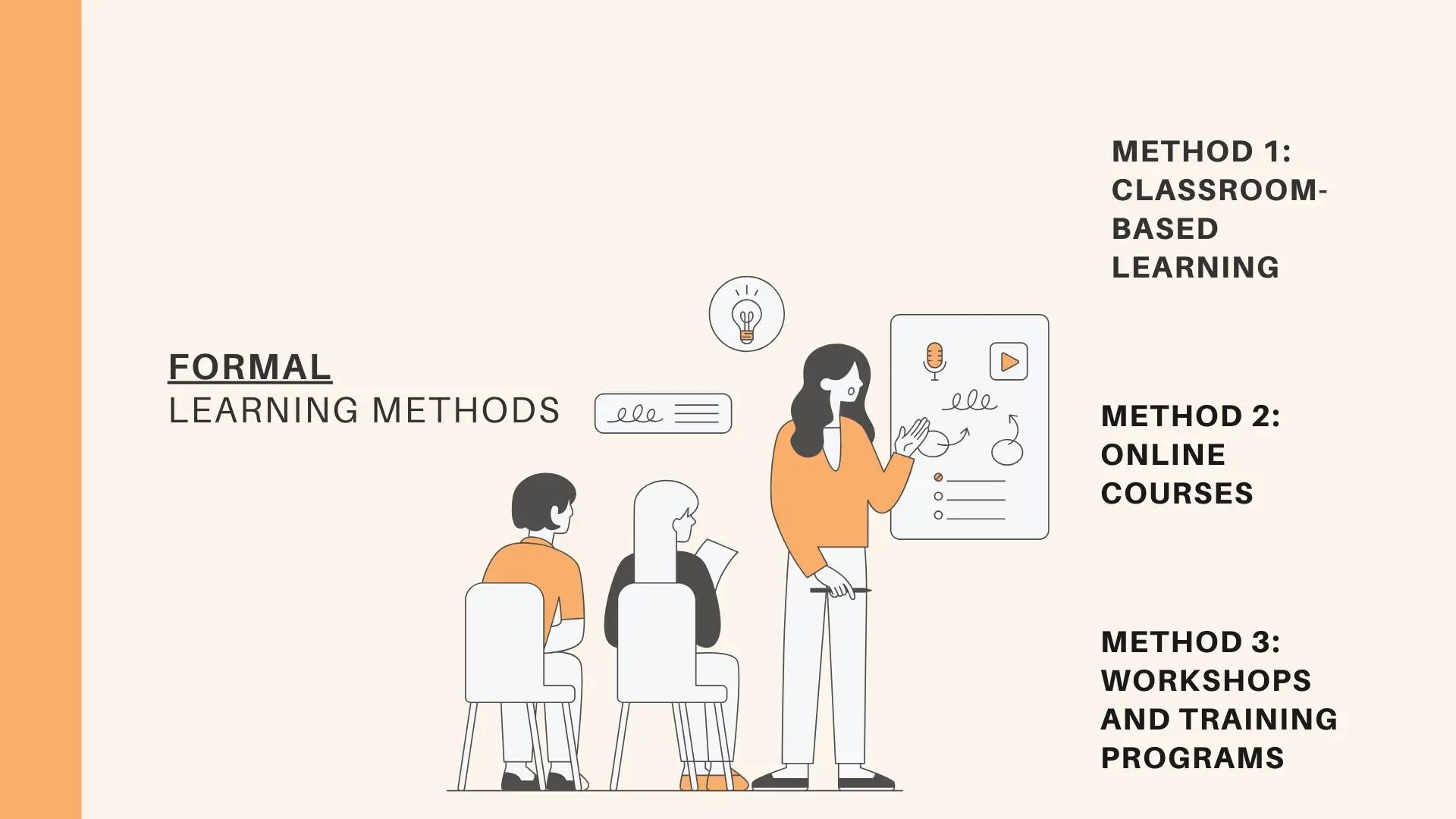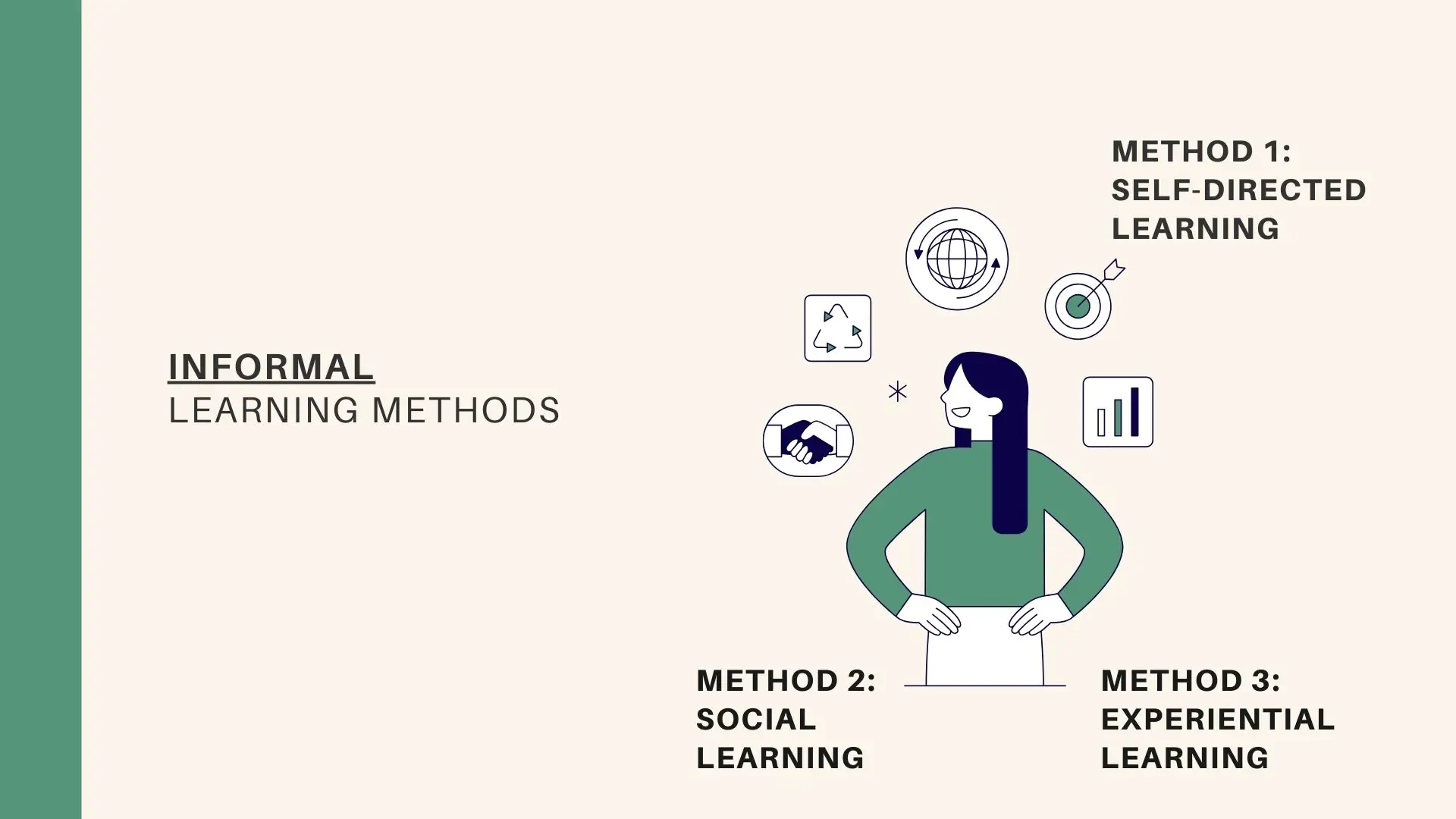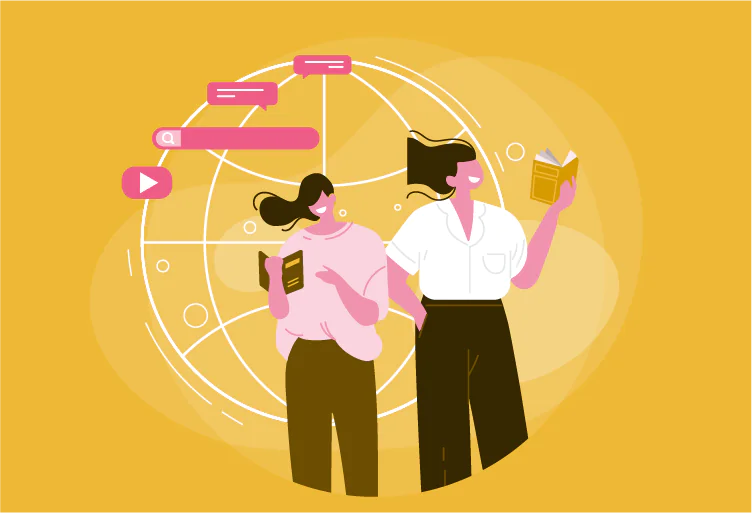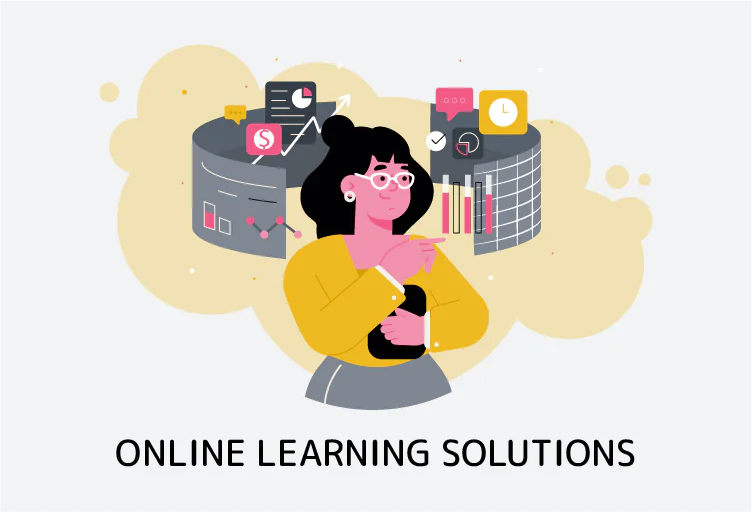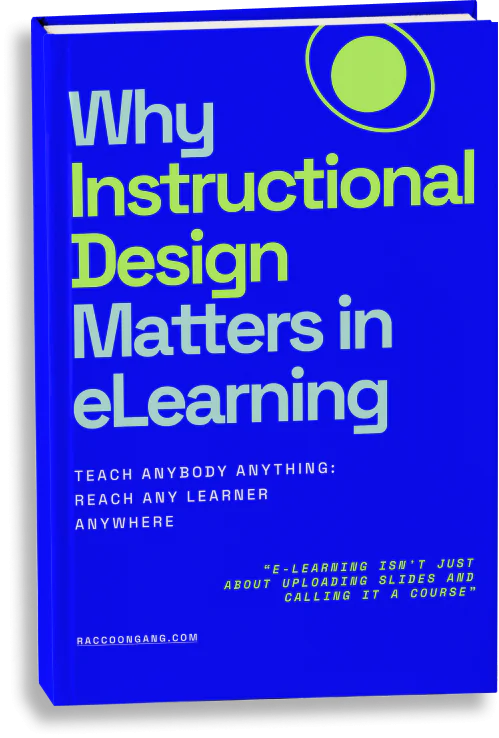Whereas formal learning happens in a training-based organization, workplace, mobile devices, classrooms, online over the internet, and through e-learning portals, informal education is based on practical and continuing education. Informal learning is a crucial concept, especially for individuals who must stay abreast with rapid technological and economic changes. While informal learning symbolizes a key to entering the world of employment, it also represents the steps in building a successful career.
Key Differences Between Formal and Informal Learning
By definition:
Formal learning occurs in a structured and organized environment like a training/education institution or on the job. It is explicitly designed as education in terms of time, objectives, and resources. It is purposeful training from the perspective of the learner, leading to degrees and certificates. Formal instruction is a structured model that presents a rigid curriculum that complies with laws and regulations. It is more of a presentation education.
On the other hand:
Informal education happens outside traditional classrooms. It doesn’t follow the structure of a school, college, or university. This type of learning takes place in daily life. It also includes self-directed projects where we teach ourselves.
This training is based on daily life experiences like peer groups, family, media, or any other influence in the learner’s surroundings. This learning platform covers a range of activities: researching the collection of the International Gallery, studying culinary skills at a community center, participating in a project on a volunteer basis, etc.
In other words, informal training often involves learning things without being aware of the learning process. This may include picking up information from TV, over the internet, films, direct interaction with individuals or any other informal way.
Formal vs. Informal Learning
To understand the difference between formal and informal education approaches, think of these two approaches as riding a bike vs. riding on a bus.
- If you are on a formal learning bus, the bus driver decides the destination of the bus or where it is going. However, the passengers are just along for the ride.
- If you are on a bike of informal learning, the rider decides the destination, the route, and the speed.
In other words, when choosing between informal and formal education, it is important to differentiate between intentional learning and accidental learning.
The clearest distinction between the two approaches to education comes down to whether it is unexpected or intentional.
Unexpected education occurs when a learner learns something in the course of daily life activities that they never expected. Intentional education, on the other hand, is an approach where learners set out to learn a particular thing and successfully achieve that goal.
Formal and informal learning methods
Both formal and informal methods offer unique advantages, and understanding the differences between them can help individuals and organizations choose the most effective approach for their needs.
| Aspect | Formal Learning | Informal Learning |
| Environment | Takes place in institutions like schools or universities, with controlled, optimized spaces for learning. | Can be experienced anywhere—workplaces, homes, communities—during daily activities or through self-directed exploration. |
| Structure | Highly structured, with a predefined curriculum and clear learning outcomes. It follows a consistent and organized path. | Flexible and unstructured, where learners choose the pace and direction. Learning is often spontaneous and needs-based. |
| Learner Autonomy | Learners have limited autonomy, with a structured path set by educators. | Learners have high autonomy, controlling what, when, and how they learn based on personal needs and interests. |
| Methodology | Lecture-based assignments and exams are common. Learning is often theoretical, with practical applications later. | Hands-on, experiential, focusing on real-world problem-solving with immediate application. |
| Assessment | Formal assessments such as exams, quizzes, and graded assignments are used to measure progress. | No formal assessments, progress is often self-evaluated or peer-validated through practical application. |
| Certification | Results in recognized certificates or degrees, validating skills for employers or further education. | Generally, no formal recognition, though skills gained may still be valuable in practice. |
| Duration | Time-bound, with a set period like semesters or courses. Follows a structured timeline. | Continuous and lifelong, happening throughout life without fixed timeframes. |
| Intent | Goal-oriented, aiming for specific outcomes like degrees or certifications. Learning objectives are clear from the start. | Incidental and spontaneous, driven by curiosity or problem-solving with no set objectives. |
| Delivery | Delivered by trained educators with standardized methods. Teaching is guided by professionals. | Self-directed or peer-led, often based on curiosity or immediate needs, without formal instruction. |
Formal learning methods
Method 1: Classroom-based learning
Classroom-based learning is one of the most common formal learning methods occurring within a structured educational setting. This method typically involves an instructor who delivers lessons, assigns homework, and assesses the progress of learners. Classroom-based learning often includes a mix of lectures, discussions, group activities, and individual work.
Method 2: Online courses
Online courses are another example of formal training, which involves delivering educational content through digital platforms such as learning management systems (LMS) or MOOCs (massive open online courses). Online courses offer greater flexibility and accessibility than traditional classroom-based learning and often include multimedia content, quizzes, discussion boards, and other interactive elements.
Ready to take your online education to a higher level? Explore Tanuki, our innovative SaaS LMS for online courses. With effortless hosting, multilingual support, regular platform upgrades, and free access to the powerful analytics tool, Tanuki empowers educators and organizations to create, manage, and deliver engaging online courses effortlessly. Discover the future of online education—visit the Tanuki homepage.
Method 3: Workshops and training programs
Formal learning also encompasses workshops and training programs, which are typically shorter and more focused than traditional classroom-based courses. These training experiences often target specific skills or knowledge areas and are led by expert facilitators. Workshops and training programs can be delivered in-person or online, depending on the needs and preferences of the learners.
Informal learning methods
Method 1: Self-directed learning
Self-directed education is an informal method of study in which individuals take the initiative to define their educational goals, develop a plan, and seek resources to achieve their goals. This method often involves reading books, watching videos, or researching online to acquire new knowledge or skills.
Method 2: Social learning
Social learning is an informal approach to education that relies on interaction with other people, such as colleagues, friends, or mentors. This method can involve learning through conversations, networking events, online forums, or social media platforms. Social learning capitalizes on the power of shared experiences and diverse perspectives to foster knowledge acquisition.
Method 3: Experiential learning
Experiential education is a hands-on, informal method of training that involves teaching through real-life experience and practice. This approach can include job shadowing, internships, volunteering, or simply trying new tasks or projects at work. Experiential education emphasizes the importance of training by doing and encourages learners to reflect on their experiences to improve their skills and understanding.
How to Settle On a Formal and Informal Learning Approach?
As stated earlier, the choice between the formal and informal learning approach comes down to the intention, objective, challenges and how any of these learning patterns facilitates the learner in developing a successful career path and to perform at their full potential.
There are three major areas in which either of these learning approaches can be tested from both the learner’s and instructor’s point of view, including;
- Content development
- Targeted audience
- Tracking of performance
In addition, each of these training patterns offers different values in the lives of the learners. Again, the choice between the two comes down to the objectives and intent of the learners.
As with just about every other methodology, formal and informal learning approaches also have differences when it comes to studying basics. Let’s discuss these basic differences separately.
Organized learning environment
Formal learning is about having a designed and structured course outline. This educational approach is formulated, pre-defined, and has a deadline. It is limited and is best suited for those who have just started their basic training or need to acquire a specific set of skills in a certain amount of time. Informal education does not mean ill-conceived or unorganized. It simply does not have clearly defined rules or formulas. It can occur anywhere, anytime, and in different contexts, including surfing the internet, work, or leisure activities. It’s not about communicating training results in advance but about balancing a clear path of study with informality.
Eager and self-motivated Learners
In the formal learning environment, the learners are usually motivated and eager to learn in the initial stages of the training course. However, gradually and in the absence of any specific activities to keep the audience engaged, the learners start losing their eagerness to excel. In other words, formal learning requires strategically engaging content to maintain the motivation level of the learners throughout the course.
Unlike formal learning, informal learners are always motivated, more attentive, and eager to learn the skill. Since they learn in a contextual environment and from experiences, they are not only interested in gaining deeper knowledge, but they also get a better understanding of the subject under discussion.
Spontaneous Learning
Informal learning is spontaneous and happens anytime and anywhere. The learner self-motivates and eagerly gains knowledge about a specific topic, or may feel an impulse to become familiar with a new one. From an instructor’s point of view, during informal learning, the instructor is conscious of the need to share the skill or knowledge with the learner in a particular context.
For instance, if a new employee has no idea about operating a copy machine, some other colleague may instantly demonstrate it in practice and how to get the job done. This informal way of obtaining knowledge is a quick help for the new worker and one of the best examples of a spontaneous and informal learning context.
However, in formal education, instruction is planned, directed, non-contextualized, and formulated. The instructor and learners take up the training course intentionally and with a clear objective in mind. Training is limited in time and has certain boundaries, which makes it impossible to fully control the educational process.
Lifelong learning process
While formal learning serves specific objectives within defined time frames, lifelong learning offers a dynamic and continuous educational journey. Take, for example, a certification course with a two-month duration; it’s designed for a particular goal within a set timeframe.
In contrast, informal learning is a spontaneous and lifelong activity that evolves with age. We start out as curious children teaching our parents, grow up studying with our peers and colleagues, and even continue to learn from younger generations as technology evolves. This ongoing process keeps individuals vibrant, engaged, and mentally active, contributing significantly to intellectual self-development.
At Raccoon Gang, we embrace the value of lifelong learning. Our Continuous Education Solution empowers institutions to foster this enriching journey, providing the tools and support needed to nurture intellectual growth throughout life. Visit our Continuous Education Solution page today.
Quantifiable Learning
The formal learning is always quantifiable. It is measurable and formulated. It is a learning or transfer of knowledge in a proper university or classroom setup, offered by skilled instructors and up to a certain degree. For example, if you need to take a particular course, you must take beginner, advanced, or master-level courses to gain the required knowledge. The outcomes are measurable and you know the skill set that you can achieve after taking a certain level of formal education.
Informal learning is, however, quite difficult to quantify. It is not measurable or pre-designed to achieve a particular set of skills in a set time frame. Since it is not a tangible training approach, there are no tracking or exams to gauge the skill set, just like certifications or degree courses. The outcomes are difficult to measure. This is indeed one of the biggest challenges of informal learning, i.e., the validation and recognition of the informally obtained knowledge in order to make it valid, valuable, and visible to others for its proper utilization.
The Future Relevance of Formal and Informal Education
So, which of these two learning approaches is most relevant in the future? There are some difficulties in combining both of these teaching methods. Both offer their own distinctive educational experience, so it all comes down to the student’s learning goal.
In informal learning, the learner gets the ability to develop more capacity for self-directed approaches towards enduring learning. Anyone who does it and develops these skills gains a great advantage over others who are persistently reliant and submissive to various influential figures to tell them when to learn, how to learn, what to learn and when to stop learning.
Considering the corporate perspective, there may be some jobs that would praise for following the guidelines or commands of a micro-managing boss, but the growing corporations are now shifting this trend.
In today’s competitive environment, it is all about taking the initiative. This is the era of working in a contextual environment rather than the theoretical world. To deliver and handle the problem upfront and pursue solutions right away. That is why it is important for a learner to make a smooth transition from formal to informal.
The Crucial Shift: Fostering Self-Directed and Continuous Learning
This transition promises the idea of ‘continuity.’ In other words, traditional schools can seamlessly integrate an open or informal education system.
It is all about offering learners a chance to determine their learning pace. They should be set free to move around and search for the best sources to learn with full motivation and keenness.
The key is to let them make the most of the available means to master the subjects that catch their interest. Similarly, reducing the core elements of a formal learning approach may involve giving learners complete freedom to choose subjects, activities, and content, as well as determining the time allocated for each stage.
In a nutshell, in going from formal to informal education, we are actually perforce displacing our ‘center of gravity’ from the processes of traditional or formulated school systems to that of students’ learning objectives.
In this evolving educational landscape, another crucial dimension is emerging — mobile learning. As traditional boundaries blur and learners seek dynamic, accessible, and on-the-go education, mobile learning has become an integral part of the modern educational process. It offers the flexibility to access education materials anytime, anywhere, meeting the unique needs of today’s learners. Just as the shift from formal to non-formal learning is important, so is the seamless integration of mobile learning. It empowers learners to embrace continuous education while adapting to the ever-changing demands of the digital age.
The Final Word
It is dependent on the pre-defined norms of the institutions whereas the learners’ interest and needs fade away. Conversely, an informal learning approach succeeds to convert the needs and interest of learners in a more adaptive and flexible formation.
The content developers must recognize and consider the range of training opportunities in course design. They must iron out the objectives and needs of the learners first and then design a custom eLearning solution that makes the most sense for learners. In this way, they can find the optimal approach to education that combines both formal and informal learning.
FAQ
How can I integrate formal and informal learning to improve my personal development?
Integrating formal and informal methods can be a pivotal step for personal development. Start with competency-based education through structured e-learning modules on platforms like Open edX to master key skills. Then, incorporate the following informal approaches:
- Microlearning or job-embedded learning to apply knowledge in real-world situations.
- Self-paced and experiential learning to explore topics at your own pace while engaging in practical activities.
- Participating in social activities via discussion forums or peer-to-peer groups to help solidify what you’ve gained.
This blend creates a personalized learning pathway that balances foundational knowledge with adaptable skills, boosting knowledge retention and growth.
Do employers value informal learning experiences when hiring?
“Experiential and job-embedded approaches show that you can effectively apply theory in real-world contexts. Employers value microlearning for its ability to foster continuous skill-building and adaptive learning and its personalized approach to meeting specific educational needs. Additionally, active participation in social groups, discussion forums, and collaborative projects demonstrates initiative and teamwork, which are highly sought-after traits."
— Open edX Engineer, Raccoon Gang
Combining formal qualifications with informal efforts signals autonomy and proactive problem-solving, which employers find valuable.
For example, Raccoon Gang’s experience with creating custom learning platforms, like the Learning Experience Platform (LXP) for an association of international academic institutions, demonstrates how these tools can enhance personal development by blending structured learning with informal, user-driven education.
This LXP incorporated social learning features, personalized learning paths, and gamification, resulting in a 30% increase in user engagement within the first six months.
To see more examples of how Raccoon Gang has supported similar projects, you can explore other case studies.
Can formal education systems adopt informal methods to improve student engagement?
Traditional courses can integrate gamification, interactive simulations, and informal assessments to make the experience more dynamic. Social elements like discussion forums and peer-to-peer collaboration promote engagement, while self-paced options give students greater autonomy. Schools also benefit from microlearning and adaptive content to offer bite-sized, personalized experiences.
These approaches not only increase engagement but also strengthen knowledge retention. Contact Raccoon Gang custom education course specialists for individualized assistance in implementing informal education tools into your company’s learning routines.

